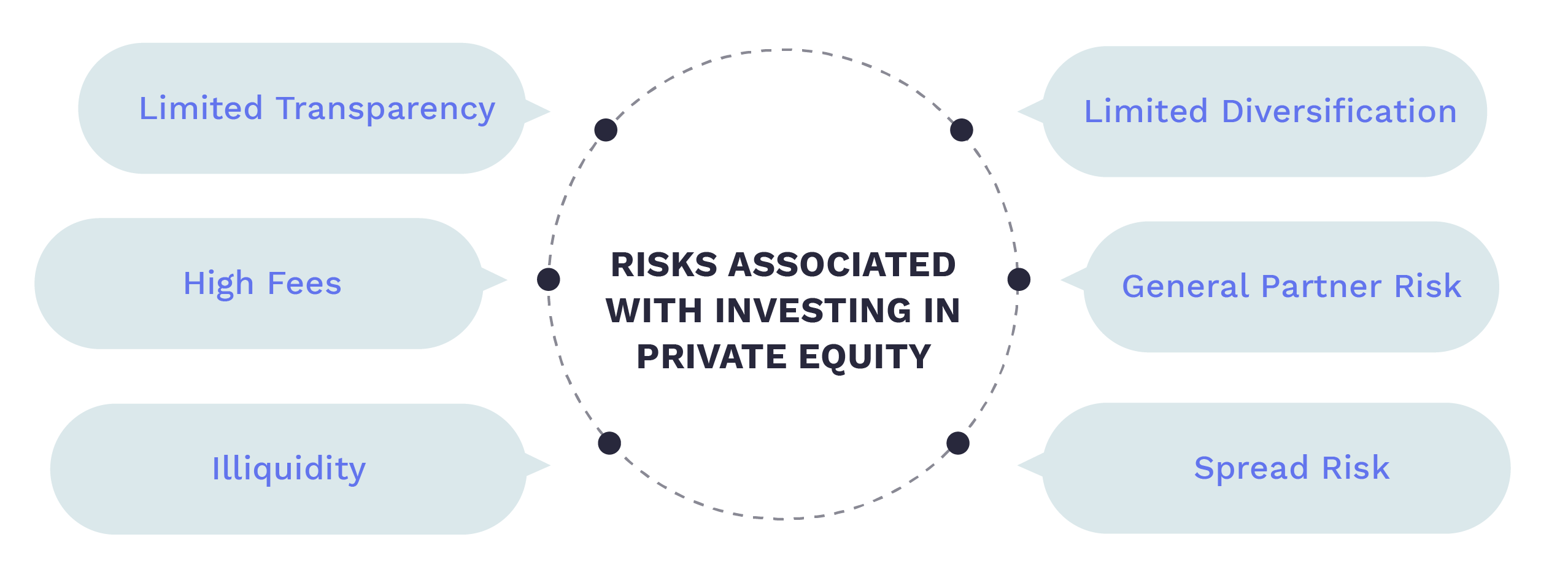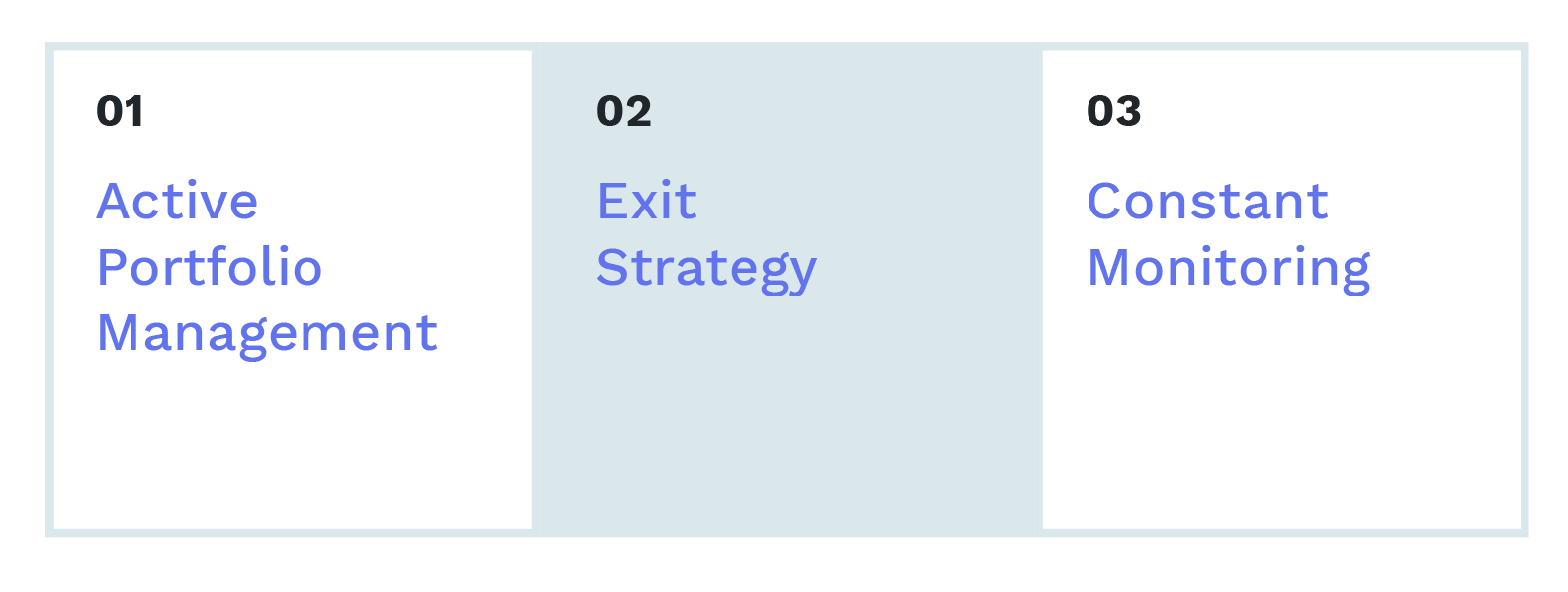There is no doubt about the fact that private equity investments are quite risky in nature. After all, you’re investing in startups and smaller businesses that are still finding their footing, in many cases. Anything could go wrong – the business plan could fail, the market dynamics could be unfriendly or the sectoral competition could be too high to survive.
Some of these risks arise due to the nature of private equity portfolio companies, primarily early-stage ventures of distressed businesses in need of restructuring. Other risks result from differences in structure and regulatory restrictions among private equity funds.
Of course, don’t get me wrong. All private equity investments will not have the same exposure to risk. You can stick to the more mature companies, for instance, if you’re looking for some stability.
Whatever the case may be, however, it is important to have an understanding of the risk mitigation methods in private equity. In this chapter, we will weigh the risks associated with investing in private equity and how to manage them.
When considering investing in private equity funds, there are some risks to be aware of. Let’s take a look at them one by one:

One of the biggest risks is the lack of transparency. Private equity firms are not required to disclose their financial information to the public, which can make it difficult for investors to understand what they’re actually investing in and how the fund is performing.
There is also the high fees associated with private equity funds. These fees can eat into your investment returns and can have a significant impact on your overall performance. It’s important to understand the fees associated with any private equity fund you’re considering investing in before making a commitment.
Another risk is the illiquidity of private equity funds. Unlike other investments, such as stocks and bonds, private equity investments are much more illiquid. This means that it can be difficult to get your money out of a private equity fund if you need it before the fund’s scheduled termination date.
Because private equity funds tend to be concentrated in a small number of companies or industries, they can be more volatile than other types of investments that offer greater diversification.
Finally, another risk to be aware of is the general partner risk. In most private equity structures, the limited partners (the investors) are at the mercy of the general partner (the private equity firm). If the firm makes poor investment decisions or otherwise mismanages the fund, the limited partners are the ones who will ultimately suffer the consequences.
Performance quartile spread risk refers to the difference in performance between different groups of private equity funds, called quartiles. If there is a wide spread between the quartiles, it means that there is a lot of variability in fund performance across the market. On the other hand, if there is a narrow spread, it suggests more consistent performance among the funds.
Private equity can be a lucrative investment option, although it involves considerable risks for investors, such as market volatility, operational challenges, and legal disputes. To mitigate these risks, it’s crucial to structure the deal appropriately.
Some of the ways to mitigate the risks are:
To ensure a successful private equity deal, it is crucial to establish a shared vision among investors, management, and the fund. This can be accomplished by defining clear and attainable objectives, implementing performance-based incentives, and collaborating on risk management strategies.
For instance, equity models can be utilised to encourage the management team to drive growth and increase the overall worth of the business. Additionally, buyers may choose to utilise earn-outs to defer a portion of the purchase price, tying it to specific milestones or outcomes.
To reduce risk in private equity, diversify the portfolio across sectors, geographies, and development stages. This helps mitigate industry shocks and competition. Invest in a mix of mature and growth-oriented companies to balance cash flow and returns. Partner with other investors or participate in multiple deals to diversify the portfolio.
Before committing to a private equity deal, conduct thorough due diligence on the fund, market, and regulations. This helps identify risks and opportunities, evaluate the business model and financial performance, and negotiate the best terms and price, Verify the information provided by the seller to ensure accuracy and completeness.
Private equity professionals frequently utilise different models to assess the performance of potential investments in various scenarios, such as market downturns, regulatory modifications, or other significant developments.
When structuring a private equity deal, the terms and conditions are crucial for managing risk and optimising returns. Consider key deal terms such as valuation, payment method, representations, warranties, covenants, and restrictions. Determine fair market value and financing, verify information, and impose obligations on the seller and fund. By doing so, investors can ensure the deal meets their needs and protect their interests.
Managing post-deal integration is crucial for a successful transition in private equity. It involves aligning culture and values, harmonising systems and processes, and communicating effectively with stakeholders. This enhances performance and reduces risks of disruptions, clashes, and disputes.

Private Equity firms rely on active management to drive their investment strategy. By taking a proactive approach, these firms can guide the direction of the companies they invest in, implement best practices, and make necessary adjustments to mitigate risks.
With a hands-on approach, private equity firms can influence the success of their investments and ensure they meet their desired goals.
Exiting an investment is crucial in private equity, and firms plan for it from the onset. They prioritise planning for the exit from the very beginning of the investment process. This enables them to manage liquidity risks and make strategic decisions throughout the investment lifecycle.
By planning to exit in advance, private equity firms can ensure they achieve their desired returns and successfully exit investments at the right time.
Private equity investments can span several years. Therefore, continuous monitoring is essential to ensure that investments remain profitable. Keeping tabs on market trends, fund performance, and geographical events helps PE professionals stay informed and anticipate potential risks. This also helps them to make strategic decisions that can maximise returns and mitigate potential losses.
Although it may not be possible to eliminate these risks, investors can adopt effective risk management strategies to reduce the level of exposure. One approach to achieve this is by asking relevant and significant questions that can provide the investor with the necessary information to make a well-informed decision.
Some of the questions investors can ask are:
As private equity investments are concentrated with 10 to 20 companies per fund, the increased risk may affect the portfolio’s value. Can the portfolio handle this concentration and will it add or reduce its value?
Despite higher fees associated with private equity, will the accumulation of returns justify the cost?
Examine the investment history of the private equity options available. Have they delivered strong returns in recent years, and is there an upward trend in their growth? One must note that private equity investments with lower investment requirements might not have extensive histories.
Each sector has its specific risks, and it is crucial to evaluate how these risks apply to particular industries and whether they justify investing in them. For instance, if the investor is considering investing in the technology sector, then they must scrutinise the operational risks more closely.
TERMS OF USE
Thank you for your interest in our Website at https://unlistedintel.com/. Your use of this Website, including the content, materials and information available on or through this Website (together, the “Materials”), is governed by these Terms of Use (these “Terms”). By using this Website, you acknowledge that you have read and agree to these Terms.
NO OFFER, SOLICITATION OR ADVICE
Our site is provided for informational purposes only. It does not constitute to constitute (i) an offer, or solicitation of an offer, to
purchase or sell any security, other assets, or service, (ii) investment, legal, business, or tax advice, or an offer to provide such advice or (iii) a basis for making any investment decision.
The Materials are provided for informational purposes and have been prepared by Oister Global for informational purposes to acquaint existing and prospective underlying funds, entrepreneurs, and other company founders with Oister Global's recent and historical investment activities.
Please note that any investments or portfolio companies referenced in the Materials are illustrative and do not reflect the performance of any Oister Global fund as a whole. There is no obligation for Oister Global to update or alter any forward-looking statements, whether as a result of new information, future events, or otherwise.
PURPOSE LIMITATION AND ACCESS TO YOUR PERSONAL DATA:
We will only collect your personal data in a fair, lawful, and transparent manner. We will keep your personal data accurate and up to date. We will process your personal data in line with your legal rights. We use your name and contact details, such as email, postal address, and contact number to continue communications with you. We may also use your contact information to invite you to events we are hosting or to keep you updated with our news.
USE OF COOKIES OR SIMILAR DEVICES
We use cookies on our website. This helps us to provide you with a better experience when you browse our website and also allows us to make improvements to our site. You may be able to change the preferences on your browser or device to prevent or limit your device’s acceptance of cookies, but this may prevent you from taking advantage of some of our features.
MATERIAL
The material displayed on our site is provided “as is”, without any guarantees, conditions, or warranties as to its accuracy, completeness, or reliability. You should be aware that a significant portion of the Materials includes or consists of information that has been provided by third parties and has not been validated or verified by us. In connection with our investment activities, we often become subject to a variety of confidentiality obligations to funds, investors, portfolio companies, and other third parties. Any statements we make may be affected by those confidentiality obligations, with the result that we may be prohibited from making full disclosures.
MISCELLANEOUS
This Website is operated and controlled by Oister Global in India. We may change the content on our site at any time. If the need arises, we may suspend access to our site, or close it indefinitely. We are under no obligation to update any material on our site.
CONTACT INFORMATION
Any questions, concerns or complaints regarding these Terms should be sent to info@oisterglobal.com